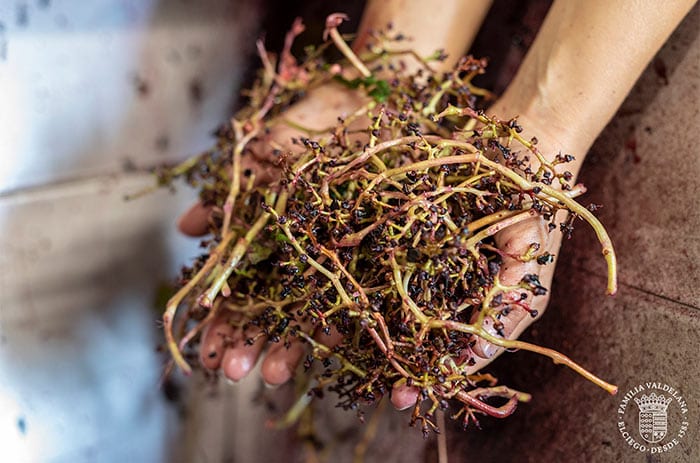What is carbonic maceration? What kind of wines does it produce? In this post we talk about carbonic maceration wines.
Carbonic Maceration is one of the two wine making techniques that are used in Rioja. Before the arrival of the French in the XVIIIth century, all wines in Rioja were made using this technique. The modern way of wine making is called destemming: removing the stems of the grape bunches before putting them in the fermentation tank. In Carbonic Maceration on the other hand, the bunches are put intact inside of the fermentation tank or vat, so the fermentation begins inside of the grape and continuous together with the other grapes in the tank. At North Coast Tours, we make sure that we show you both styles of wine so that you can compare them. You can book a wine tour with us on our website: https://northcoastours.com/rioja-wine-tours/
Next, we show you a little bit of history about these unique wines, which are so appreciated by local consumers.
What is carbonic maceration?
To explain carbonic maceration, we are going to compare this procedure with the one commonly followed to make wines. Generally, in winemaking, destemming and crushing are carried out. Destemming consists of separating the grape grain from the stalk, avoiding the possible unwanted herbaceous and astringent tones that the stalk provides. Once separated, the grape grains are squeezed obtaining must, which will macerate in the tank next to the grape skin. This process facilitates fermentation. Alcoholic fermentation will take place in the tank, a transformation process by which the sugar is converted into ethyl alcohol and carbon dioxide is released.

The main difference in carbonic maceration is that, in this process, the grapes are neither destemmed nor crushed: the grape clusters enter the tank whole. In this way many intracellular fermentations take place. During this process, carbon dioxide (CO2) does not come off, but remains retained in the berry.
Winemaking by this method has two stages. In the first, fermentation begins in whole grains, beginning with the action of enzymes (anaerobic). This process takes 10-12 days, depending on the temperature and production conditions. The second stage corresponds to the alcoholic fermentation of the pressing of the must and grapes from the previous stage.
Brief history of carbonic maceration
Carbonic maceration wines are those made by winegrowers with their own harvest. These wines were consumed in the same year and marketed locally. Historically, this type of production has been very characteristic in Rioja Alavesa. Until the 18th century this was the only known production process. At that time the stem of the grape began to be removed before starting the fermentation and squeezing the grapes.
With the arrival of the winemaker Jean Pineau, considered the father of modern Rioja wine, a whole wine revolution began in the 19th century. He establishes this new fermentation process separating the berry from the stalk. Another of the great revolutions that he introduced was that he stopped keeping wine in large casks and started working with small casks. With this type of container it was possible to extend the life of the wine, give it another flavor and other aromas, making it a finer and more elegant wine.
Pineau led the Medoc Alavés project, considering wine as an item that can be produced and sold, and not just made for self-consumption. This brings an important change in the production, conservation, preparation and marketing of wine.
When are carbonic maceration wines on the market?
Those who are passionate about carbonic maceration always try to taste these wines as soon as possible. Tasting them in November may be a bit premature, but it is a good way to make a first assessment of the new vintage. They are naked wines, without makeup, pure soul. They tell us about what has happened in a specific place during a year, about inclement weather, agricultural adversities and the skill of its author.

Could crianza or reserva wines be made with this technique?
Traditionally, carbonic maceration wines have not been considered suitable for aging in barrels and bottles. Now, if the raw material is optimal, it has good maturity, structure and stability, so these wines can have a long and positive age. There are no secrets here: if the grapes are good, the wine will be good, although they must be treated differently from the beginning than conventional wines. The shelf life of carbonic maceration wines is indicative, although they are usually in their fullness during the first and second year after their production.
Characteristics of carbonic maceration wines
Carbonic maceration wines have a lot of personality, something that can become very palpable if we taste them. Starting with the sense of sight, wines are created with a great coloring intensity, purple with a very high layer.
On the nose they offer a great family of aromas with a unique fruit character. They are very aromatic wines where red fruits and berries predominate, although they also show floral and balsamic notes.
In the mouth they are sweet and give a creamy sensation. Its memory is fresh, jovial, it is the sensation of taking a bite of a freshly cut grape. By tradition they are the wines that accompany our lunches.
Credit: 15/02/2021 Bodegas Valdelana







